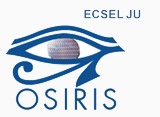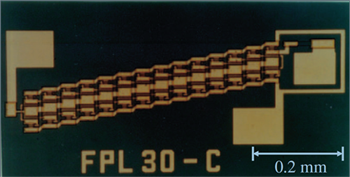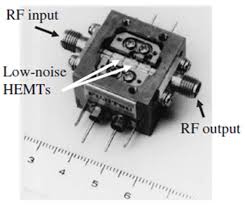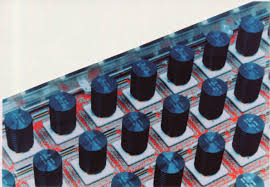 2 HEMTs invention
2 HEMTs invention
2.1 History
.
- In the 1979 Takashi Mimura and colleagues developed the first HEMT (AlGaAs/GaAs system) at Fujitsu in Japan. The HEMT was based on the concept of modulation doping first demonstrated by Ray Dingle and his collaborators at Bell Labs in 1978.(1,2)
- In Europe, Daniel Delagebeaudeuf and Trong Linh Nuyen from Thomson-CSF (France) filed for a patent of this device on the 28th of March 1979.(3)
- In 1980 Takashi Minura, Fujitsu laboratories designed the features of the first HEMT.
- In 1981 Fujitsu had demonstrated the first HEMT integrated circuit featuring an enhancement/depletion-mode logic ring oscillator that showed a switching delay of 17.1 ps, “the lowest of all the semiconductor logic technologies reported thus far” (Fig. 2.2).

Fig. 2.2 First HEMT integrated circuit: 27-stage ring oscillator
- In 1985 the manufacturing capabilities had grown to such a level that the HEMT structure was announced as the device with the lowest noise characteristics in the world.

Fig. 2.2 First commercial HEMT: cryogenic low-noise amplifier for radiotelescope at Nobeyama Radio Observatory(4)
- In 1987 - Commercialization of HEMTs significantly increased in Japan and Europe and HEMTs began to replace GaAs MESFETs in broadcasting satellite receivers. HEMTs made it possible to reduce the size of a parabolic antenna by one-half or more.
- In 1988 - HEMT multibit data registers(5) were developed for the supercomputer of the National Research and Development Program of Japan.
 Fig. 2.3. HEMT multibit data registers mounted on circuit board of supercomputer.
Fig. 2.3. HEMT multibit data registers mounted on circuit board of supercomputer.
- Early Applications: Low noise amplifiers (Installed in radio telescope), other space and military applications, satellite broadcasting receivers. The transistor quickly gained popularity and spread all over the world.
- In 1993 Asif Kahn demonstrated the first AlGaN/GaN HEMT.(6)
- Commercial production took off in the 90’s. In the last 30 years, HEMTs have been demonstrated in several material systems, most notably AlGaAs/GaAs and AlGaN/GaN.(7)
__________________
| (1) | R. Dingle et al., Appl. Phys. Lett. 33, 665 (1978). |
| (2) | Edward C. Niehenke, The Evolution of Transistors for Power Amplifiers: 1947 to Today, IEEE, 2015, [online] |
| (3) | US 4471366, Daniel Delagebeaudeuf and Trong L. Nuyen, "Field effect transistor with high cut-off frequency and process for forming same" google patents link |
| (4) | Takashi Mimura, Development of High Electron Mobility Transistor, Jpn. J. Appl. Phys., Vol. 44, No. 12 (2005), pp. pp. 8263–8268 |
| (5) | M. Asif Khan et al., Appl. Phys. Lett. 60, 3027 (1992) |
| (6) | M. A. Khan, A. Bhattarai, J. N. Kuznia and D. T. Olson: Appl. Phys. Lett. 63 (1993) 1214 |
| (7) | H Xing, S Keller, Y-FWu, L McCarthy, I P Smorchkova, Gallium nitride based transistors, J. Phys.: Condens. Matter 13 (2001) |